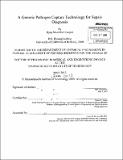A generic pathogen capture technology for sepsis diagnosis
Author(s)
Cooper, Ryan Mcomber
DownloadFull printable version (19.36Mb)
Other Contributors
Harvard--MIT Program in Health Sciences and Technology.
Advisor
Donald E. Ingber.
Terms of use
Metadata
Show full item recordAbstract
Sepsis is a systemic inflammatory response that results the presence and persistence of microorganisms or their toxins in the bloodstream and it is diagnosed by detecting the presence of pathogens in blood. Despite improvements in modem medicine, sepsis has a high mortality rate that increases rapidly with every hour the patient does not receive optimal antibiotic therapy. Thus, there is a great demand for technologies that can accelerate pathogen detection and sepsis diagnosis. Our lab previously developed a micromagnetic-microfluidic pathogen isolation technology that can selectively remove pathogens from flowing whole human blood with high efficiency using micro- or nano-sized magnetic beads coated with microbe-specific antibodies [1, 2]. However, the identity of the pathogen is not known when a patient first presents with the clinical symptoms of sepsis, and currently, it can take days to a week to identify the specific pathogen type. The goal of this dissertation is to develop a generic pathogen collection technology that can be used to pull bacteria and fungi out of blood or other fluids without first knowing their identity, and to concentrate them for analysis and rapid identification. In Chapter 1, 1 will review the field of sepsis diagnostics and methods that have been employed to confront this challenge. In Chapter 2, I describe the development of a natural human opsonin - Mannose Binding Lectin (MBL) - as a generic pathogen capture molecule. MBL is found in human blood and is part of the innate immune system; it has been previously shown to bind over 90 different types of pathogens, including gram negative and positive bacteria, fungi, viruses and parasites [3-5]. The studies described in this chapter include development and optimization of methods to coat magnetic beads with MBL and demonstration that MBL beads bind to wide range of pathogens with high efficiency in saline and blood. The binding of MBL beads to sample pathogens is tested under a wide range of conditions to determine optimal bead concentration, binding time and sample treatments to maximize binding in blood. In Chapter 3, 1 describe development of a device that efficiently concentrates and visualizes fungi tagged with the magnetic MBL micro beads. Visualization is made possible by controlling the balance of fluidic shear stress and magnetic force on the tagged pathogens in the device, which enables spreading of the beads and bound fungi into a uniform layer that can be quickly quantified with fluorescent microscopy. Chapter 4 describes tools that I have developed to rapidly concentrate and purify magnetically tagged bacteria from blood and other complex samples for polymerase chain reaction (PCR) detection. The MBL-bead approach is used to pull out and concentrate pathogens from large sample volumes, and to remove contaminating human DNA, so that sensitive detection can be carried out using PCR amplification. The efficiency of this new MBL-based, sample pre-concentration method is compared to existing commercial isolation methods for analysis of both blood and food samples. Finally, I discuss the implications of these findings in Chapter 5.
Description
Thesis (Ph. D. in Medical and Engineering Physics)--Harvard-MIT Program in Health Sciences and Technology, June 2013. "May 2013." Cataloged from PDF version of thesis. Includes bibliographical references (pages 121-127).
Date issued
2013Department
Harvard University--MIT Division of Health Sciences and TechnologyPublisher
Massachusetts Institute of Technology
Keywords
Harvard--MIT Program in Health Sciences and Technology.